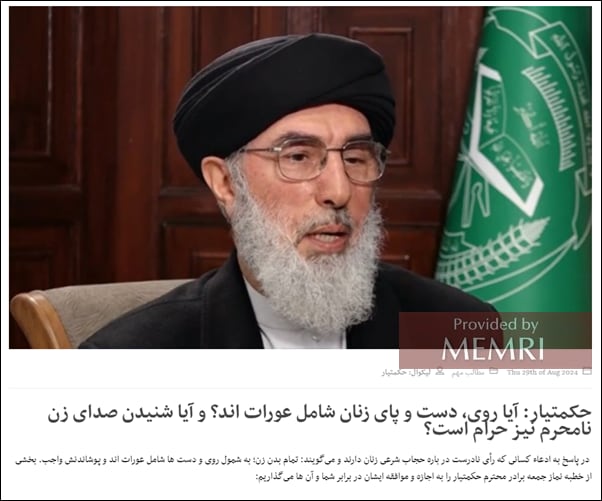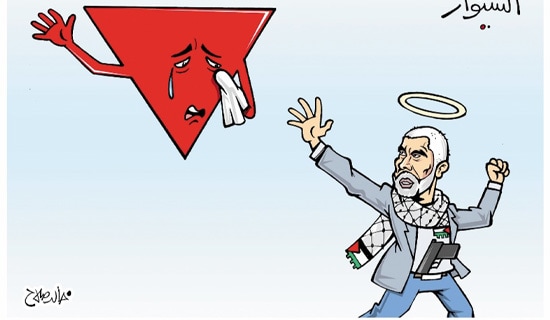On August 29, 2024, the Afghan outlet Daily Shahadat published[1] a sermon of Gulbuddin Hekmatyar, leader of Hizb-e-Islami Afghanistan and former mujahideen commander, in Dari, questioning a law[2] passed in August by the Taliban government's Ministry for Propagation of Virtue and Prevention of Vice requiring that women be completely covered in public, including their faces, and not raise their voices. Referring to verses from the Quran and hadiths of Prophet Muhammad, Hekmatyar argues that it is unnecessary for women to cover their faces and hands, even during daily prayers and the annual Hajj pilgrimage.

Following are translated excerpts from the report on Hekmatyar's sermon:
"The Extent Of Hijab For Women Is The Same As What Must Be Observed During Hajj And Prayer: In Prayer, She Is Not Required To Cover Her Face, And During Ihram [A State Of Consecration During Hijrah], She Is Not Required To Cover Her Face Or The Palms Of Her Hands"
"Are the face, hands, and feet of women considered Awrah [private, requiring covering]? And is hearing the voice of a non-mahram [i.e., one not related by blood or marriage] woman also considered haram?
"In response to the claim of those who hold incorrect views about the shari'a hijab for women and say that a woman's entire body, including her face and hands, is considered awrah and must be covered, we present part of the Friday prayer sermon by the respected brother [leader of Hizb-e-Islami Afghanistan Gulbuddin] Hekmatyar with his permission and consent, for you and them:
"Allow me to have a discussion about hijab, which is a hot and sensitive topic of the day.
"If Islam, on one hand, is against nudity and links it to satanic temptations stating that Satan wanted to disrobe the person [i.e., Adam] to take him out of paradise, [Islam] also has its exact scientific guidelines and instructions for men and women about how to dress for men and women. In Islamic hijab, there is nothing similar to a chador, nor is there one covering women's face and hands. Women's shari'a dress is the one similar to the one that must be observed during Hajj. A muhrima woman [i.e., one who is in a state of ihram, or consecration during Hajj] is obligated to cover neither her face nor her hands in ihram, and she is not obligated to cover her face, palms, or feet during her five prayers at home or in the mosque.
"In this regard, all Islamic jurists, religious scholars, and leaders of sects are in consensus. It can be boldly claimed that the agreement in this regard is similar to ijma [consensus]. Except for a few people who have taken an extravagant way, everyone else has the same opinion. Among the Companions [of Muhammad], figures like Abdullah ibn Abbas and Abdullah ibn Umar hold the same view... The Quranic verses and the sayings of the Prophet, peace be upon him, support this view...
"The Prophet was asked: What should a muhrim wear? He replied: He should not wear a Perahan, a turban, a cloak, or shoes that cover his legs up to the ankles (protrusion between leg and foot) ... and a muhrrim woman should not wear a mask [veil] or gloves. This riwayat [narration] is mentioned ten times in Sahih Bukhari; sometimes it is complete and sometimes it is incomplete...
"Not covering the face and hands for women is not only exclusive to Hajj and prayers. Rather, outside of these two situations and in general, this is mashroo [legitimate] for women's dress... The extent of hijab for women is the same as what must be observed during Hajj and prayer: In prayer, [a woman] is not required to cover her face, and during ihram, she is not required to cover her face or the palms of her hands."
"The [Quranic] Verses Clearly Indicate That The Face Is Not Included In The Hijab; If The Face Is Covered, Lowering The Eyes Would Have No Purpose Or Necessity, As There Would Be No Need For It"
"The Quran tells believing men and women to lower their gaze when meeting with those who are non-mahram and to protect their private parts. The purpose of this command to lower the gaze is to maintain and protect against falling into sin.
"The verses clearly indicate that the face is not included in the hijab. If the face is covered, lowering the eyes would have no purpose or necessity, as there would be no need for it...
"[Quran 24:31] 'And tell the believing women to lower their gaze and guard their chastity, and not to reveal their adornments except what normally appears. Let them draw their veils over their chests, and not reveal their hidden adornments except to their husbands, their fathers, their fathers-in-law, their sons, their stepsons, their brothers, their brothers' sons or sisters' sons, their fellow women, those bondwomen in their possession, male attendants with no desire, or children who are still unaware of women's nakedness. Let them not stomp their feet, drawing attention to their hidden adornments. Turn to Allah in repentance all together, O believers, so that you may be successful.'
"It is narrated from Abdullah ibn Abbas that during the last Hajj of the prophet, while he was in Mina and Fazl ibn Abbas was behind him, a woman asked him a question and he was busy answering it. Fazl, who was a young man, kept looking attentively at the woman. The Prophet turned his face away from her... Abdullah ibn Abbas later asked: 'Oh Messenger of Allah! Why did you do that? He replied, both were young, and I was not sure from the influence of Satan upon them'...
"This riwayat clearly indicates that women did not cover their faces during the Hajj rites until the end of the Prophet's life, peace be upon him. It is evident from this Riwayat that no other command abrogated it, because it belonged to the last days of the Prophet's life. The riwayat is as follows:
"Also, Aisha narrates that her sister Asma entered her house wearing a thin Shami [Syrian] dress. The Prophet turned away from looking at her and said, what is this, Oh Asma? When a woman reaches puberty, it is not appropriate for any part of her body to be seen except her face and hands...
"Another riwayat from Aisha [the wife of Muhammad], explicitly states that the face and hands are not included in the hijab for women. She says: We, the women of the Prophet, used to perform the Fajr [early morning] prayer together with the Messenger of Allah, while wearing long cloaks; then we would return to our homes in such darkness that we were not recognized. This means that the reason for their not being recognized was the darkness, not the covering of their faces... If there had been no darkness, they would certainly have been recognized..."
"No Quranic Verse Explicitly Or Indirectly Addresses The Covering Of The Face And Hands"
"Dear Brothers And Sisters!
"The issue of how to dress mashroo [legitimately] for men and women should be solved in a fundamental and legal way. It should be officially communicated to everyone by government officials.
"The majority of Afghans follow the Hanafi sect [of Sunni Islam]. According to the Hanafi law, women's face and hands do not include hijab. [Other Islamic jurists] Imam Shafi'i and Imam Malik also hold this view and the Shi'ites also have a similar opinion; and they follow the same opinion in Iran; they wear something similar to a jilbab [a long loose cloak].
"The verses of the Quran and the hadiths of the Prophet also support this opinion. No Quranic verse explicitly or indirectly addresses the covering of the face and hands. If the face were part of the hijab, it would have been explicitly addressed, just as it has been discussed about the greban [chest] (and related parts of this part: chest and neck)."








